Beginner's guide to online course sales funnels
Sales funnels aren't an advanced strategy for course creators – they're essential for turning prospects into paying students. If you're new to online course sales funnels, this guide will help you understand the key components and common mistakes to avoid. I'll also include examples of successful course funnels you can take inspiration from, in a variety of niches.
What is a sales funnel?
Overview
Think of an online course sales funnel as guiding someone through a journey, from first hearing about your course to eventually signing up. It’s about creating a smooth path that leads them to enrolment.
The purpose is to automate and optimize your marketing. An online course sales funnel means you can nurture leads until they’re ready to buy, without spending time on manual relationship-building.
How it works
An online course sales funnel moves prospects through different stages: awareness, interest, decision, and action. At each stage, you provide relevant content to keep them moving forward.
For example, you might start with blog posts or social media posts to build awareness, then use webinars or consultations to make the sale further down the funnel.
Regardless of the content you offer, your first step would be to create a full course launch plan to outline your funnel and traffic strategy in detail. But in this post, we’ll focus on the top-level strategy.
Why you need a funnel
Online course sales funnels aren’t an advanced strategy – they’re a foundational tool for getting students.
- Build trust - Most people need to hear from a business multiple times before they feel comfortable buying. A sales funnel helps build that trust over time in a way that isn’t possible with a more manual approach.
- Increase conversions - A funnel guides prospects through the decision-making process systematically, making it more likely they’ll convert.
- Save time - Automating your marketing on the back end means you can spend more time on outreach, customer support, and product development.
- Consistency - A successful funnel keeps a steady flow of potential students coming in, so you’re less likely to experience the feast or famine cycle.
- Improve targeting - Funnels make it easier to focus on your ideal customer avatar and people most likely to buy your course. For example, you can segment your audience based on their engagement or how they respond to surveys.
- Optimization - A funnel is easy to troubleshoot if you track key performance indicators (KPIs). If part of your funnel is underperforming, you know where to improve.
It’s harder to sell any product online without some form of sales funnel – even if it’s a basic online course sales funnel with two or three steps.
Stages of a sales funnel
Whether you have an online course sales funnel or not—every time someone buys from you, they’ll go through four stages.
Stage 1: Awareness
This is the stage where potential students are first exposed to your brand. The goal of content at this stage is to increase visibility, and success is usually measured in reach and impressions.
- Blog posts - You could write articles about your course topic with the goal of ranking on Google.
- Social media - Many course creators share content on social media to try and reach new audiences.
- Paid ads - Platforms like Facebook, Instagram and LinkedIn let you pay to put content in front of your target audience.
Pro tip
Don’t pitch your course at this stage. Even if you think you’re being subtle, new audiences will be turned off if your content has an agenda.
Stage 2: Interest
Now people are aware of your business, the goal is to nurture interest and build trust. Success at this stage of the online course sales funnel is usually measured in new subscribers, or engagement metrics like clicks or opens.
- Lead magnets - Usually, you’d offer useful resources like e-books, guides, or checklists to capture email addresses.
- Podcast episodes - If you have a podcast, you could share educational episodes about your course topic.
- Nurture sequences - Once they’re on your email list, you can send a series of emails with tips and helpful information to build the relationship over time.
Stage 3: Decision
This stage is the first time you should introduce and pitch your product. The goal is to make their buying decision easier by linking your course with their pain points and desired outcomes.
- Course information - You’ll provide detailed information about your course, including features, benefits, and what they’ll learn when they enroll.
- Social proof - Use testimonials and case studies to build credibility and trust. People feel more comfortable buying if they know others have succeeded with the product.
- Demos or free trials - You could offer a sneak peek or limited-time access to part of your course so they can experience the value firsthand.
Stage 4: Action
This is the final stage where people buy and enroll in your course. The goal is to convert people into paying students, so success at this stage is measured by number of enrollments.
- Clear CTAs - Use strong calls to action to encourage enrollment. Make it easy for them to take the next step with accessible links and clear language.
- Limited-time offers - Create urgency with special discounts or expiring bonuses. This encourages people to act quickly rather than putting off the decision.
- Easy checkout process - Make sure the buying process is smooth. You could also offer payment plans for higher-priced courses to reduce price friction.
Pro tip
Don’t skip or rush any of these stages. Every stage is essential for building a strong relationship with potential students. Take the time to get it right and the conversions will come.
Types of online course sales funnels
Download funnels
A download funnel is designed to capture email addresses by offering a valuable freebie, like an e-book, checklist, template, guide, or worksheet.
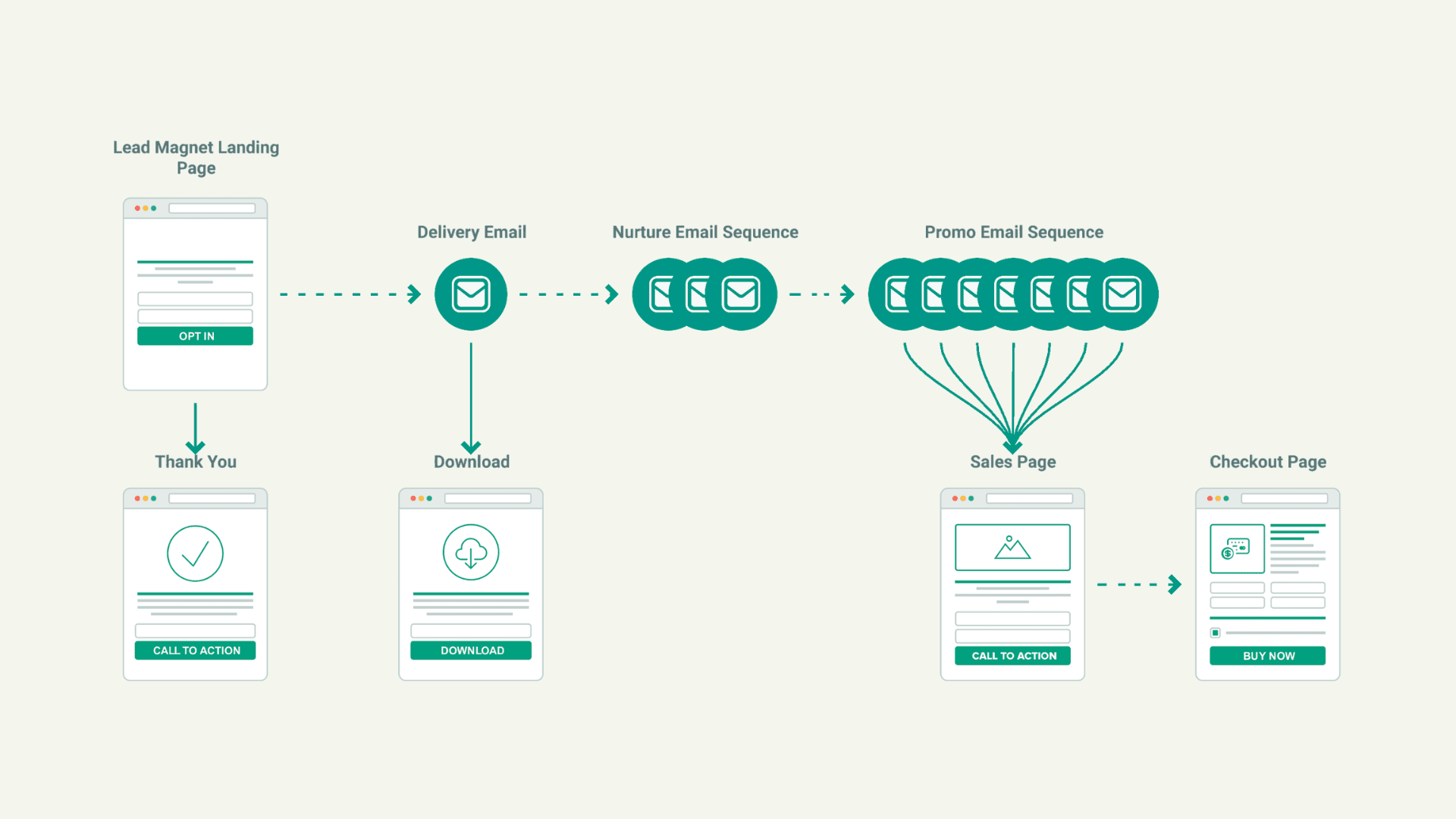
How this funnel is structured
- This type of online course sales funnel starts with a landing page where people opt-in for a freebie, followed by a thank you page.
- The freebie is delivered immediately via email, then a nurture email sequence starts to build a relationship.
- A promo sequence then tries to send them to the sales page, followed by the checkout page where they buy.
When to use a download funnel
Download funnels are easy to create, relative to other types of online course sales funnel. You can make a checklist or guide in Canva and launch it quickly.
These work best when you offer a valuable, time-saving shortcut relevant to your main product. For example, you might offer German Vocab Flash Cards if your main course teaches German.
Downsides of downloads
Download funnels don’t work well for high-ticket courses or topics that involve a big personal transformation. Both of these usually need deeper engagement than a download alone can offer.
Mini course funnels
A mini course funnel offers a short free (or low-price) course to show value and engage potential students.
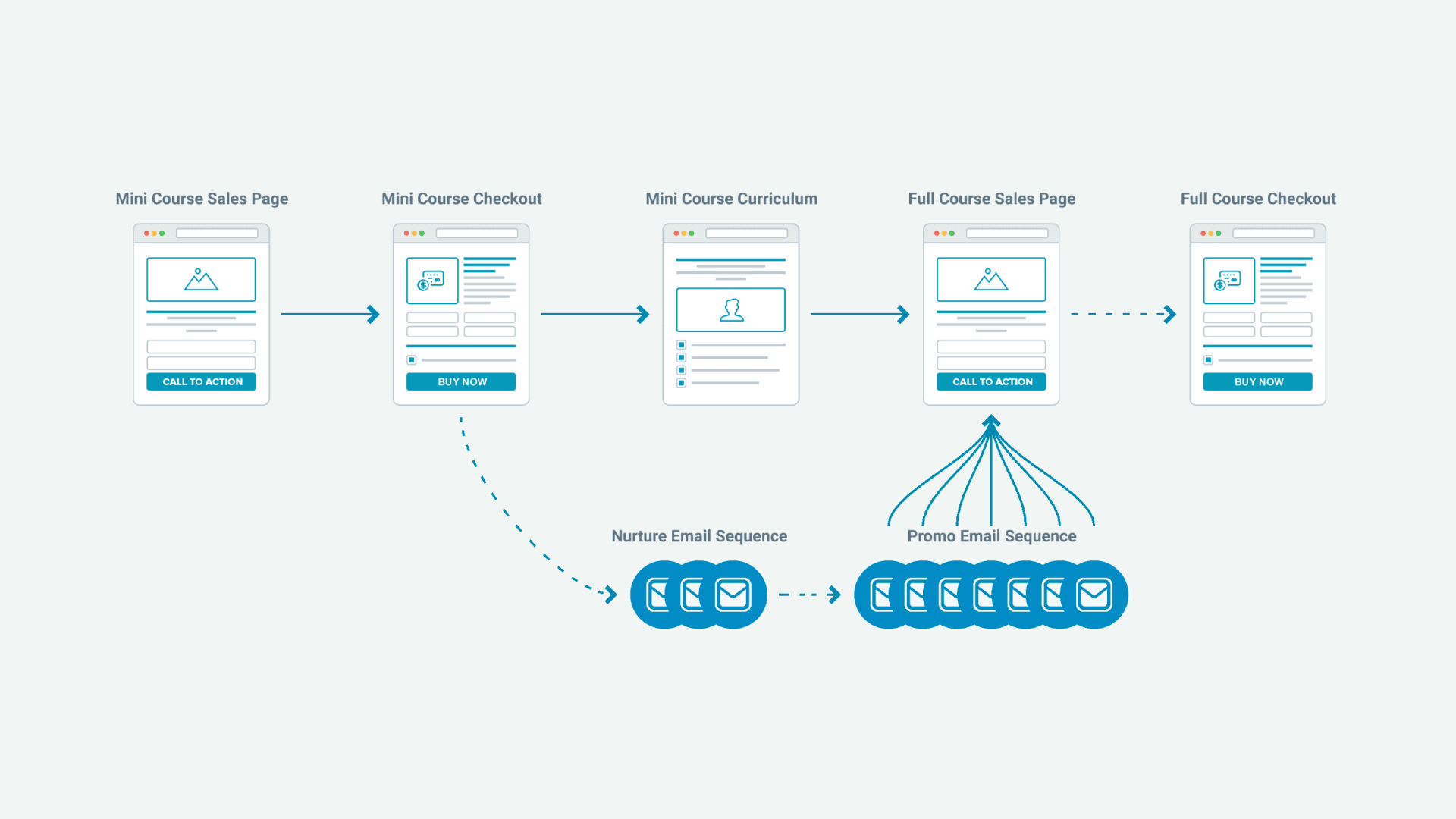
How this funnel is structured
- The funnel starts with a sales page for the mini course, followed by a sign-up page or checkout page.
- Once they sign up, they get access to the mini course. Meanwhile, a nurture sequence builds a relationship.
- After finishing the mini course, a promo email sequence leads them to the full course sales page, followed by the checkout page if they choose to buy.
When to use a mini course funnel
Mini course funnels are good for showing your teaching style and content quality. They work best when people might be skeptical about learning through your method and need a demonstration.
Downsides of a mini course
Mini course funnels can backfire if your audience believes they’ve learned everything they need to from the mini course. So make sure your mini course provides value while showing the need for further learning.
Webinar funnels
A webinar funnel is designed to engage potential students with a video presentation that starts with education and leads to a sales pitch at the end.
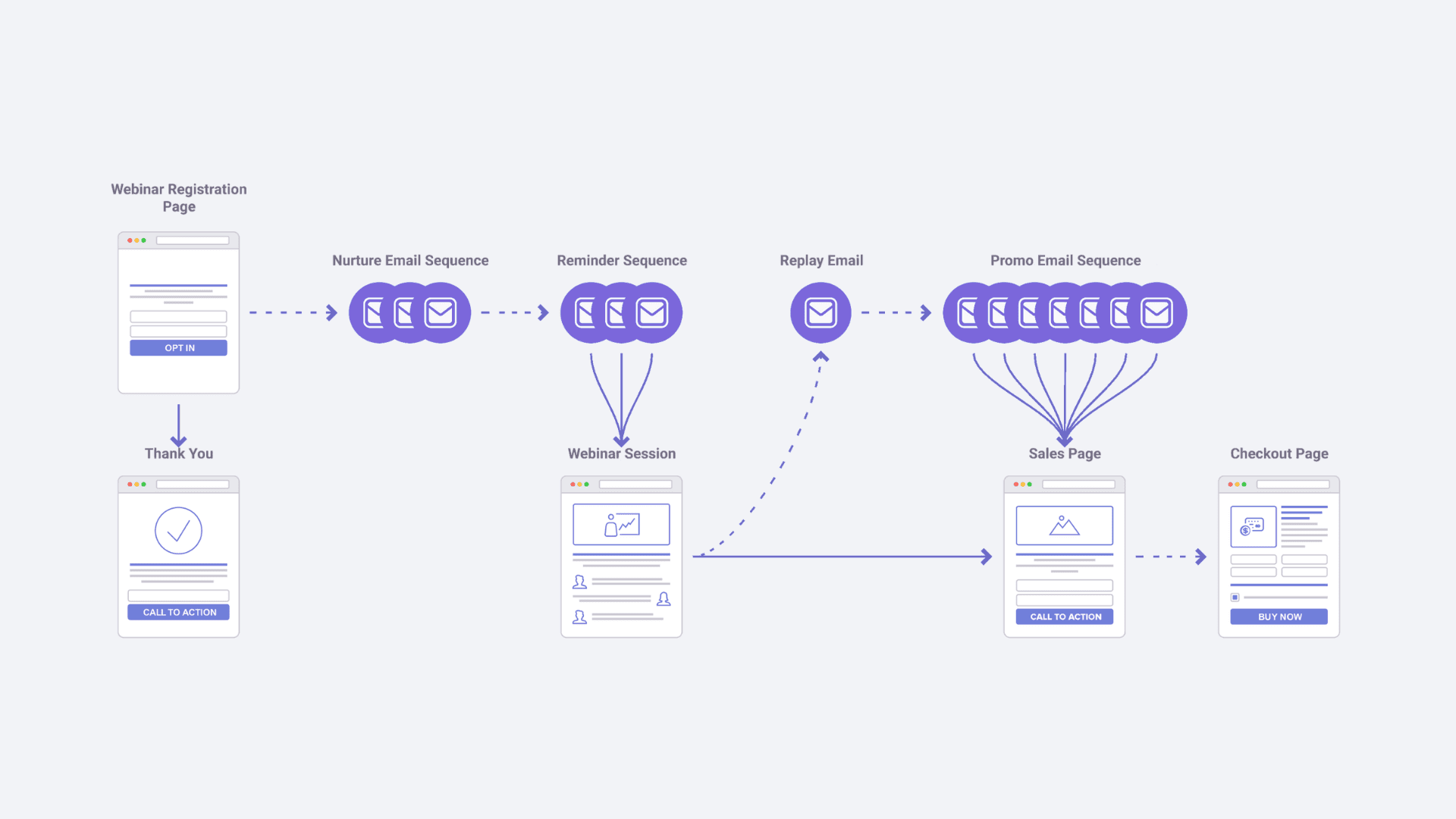
How this funnel is structured
- The funnel starts with a webinar registration page where people sign up, followed by a thank you page. (Optionally, you can also send webinar invites to your email list if you have one.)
- Leading up to the webinar, they get a nurture sequence and reminder emails.
- During the webinar, you educate and engage the audience, leading to a pitch for your course.
- After the webinar, a promo sequence sends them to the sales page, followed by the course checkout page.
When to use a webinar funnel
Webinar funnels are good for engaging with your audience on complex or deep topics. They work well when you need to build a strong connection before people will be comfortable buying.
For example, you might host a live webinar on Improving Communication for Married Couples to show your expertise and build trust before pitching your full course.
Downsides of webinars
Webinar funnels might be overkill for low-ticket items or unemotional topics. They require a significant time investment from your audience so they can add friction for simpler purchases. They can also be tricky to get right, so it’s usually recommended to hire a professional copywriter to draft your script.
Waiting list funnels
A waiting list funnel is designed to build anticipation and gauge interest by having people sign up for notifications before your course launches. The length of these kinds of online course sales funnels can vary enormously.
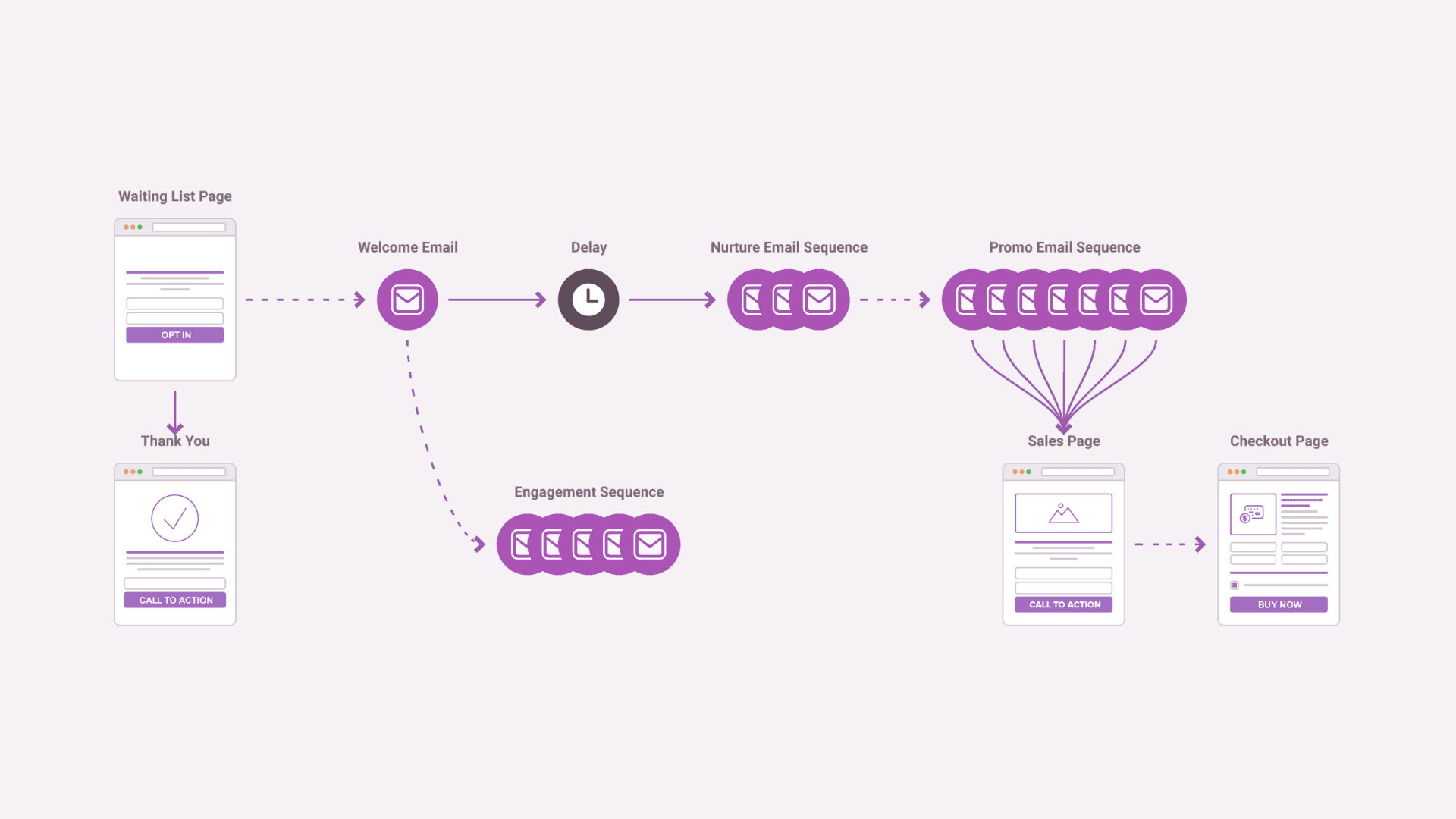
How this funnel is structured
- The funnel starts with a waiting list landing page where people sign up, followed by a thank you page.
- After signing up, they receive a welcome email, then they’re placed into an engagement sequence so you can keep them updated and engaged.
- As the course launch approaches, a nurture sequence and promo sequence kick in to send them to the sales page, followed by the course checkout page.
When to use a waiting list funnel
Waiting list funnels are ideal when you haven’t finished your course yet or are planning a live launch. They help gauge interest and build an eager audience before the course is available.
Downsides of waiting lists
Waitlist funnels aren’t necessary for evergreen courses that are always available. They also need ongoing communication to keep the audience engaged, so don’t leave a huge delay before launch.
Quiz funnels
A quiz funnel engages your audience by offering them a quiz, followed by personalized results and segmented nurture content.
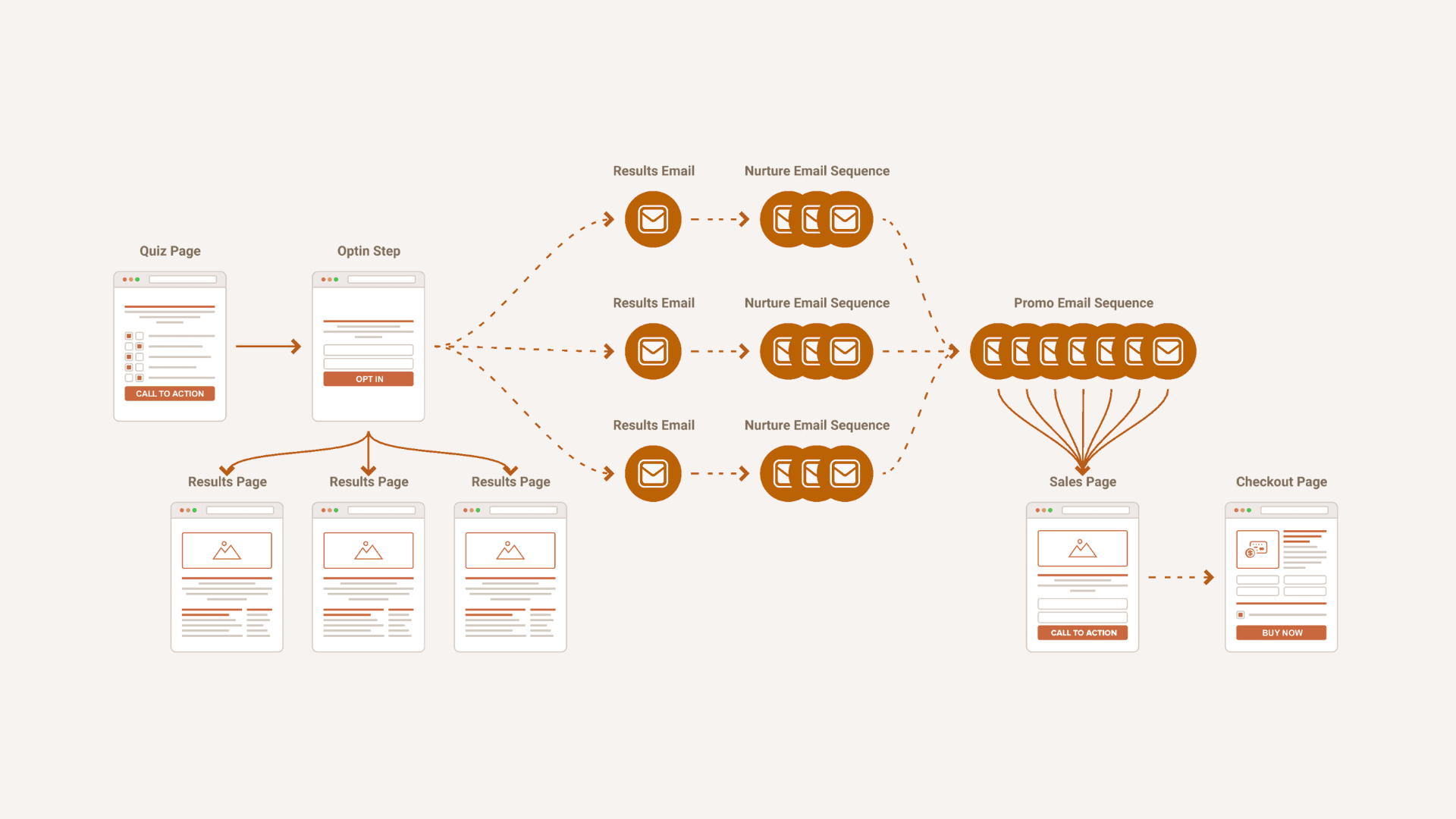
How this funnel is structured
- The funnel starts with a quiz landing page where people take the quiz, followed by an opt-in form if they want to see their results.
- The thank you page shows their results, plus some nurture content tailored to their answers.
- They immediately receive a welcome email with their results, then they’re placed into a nurture sequence with tailored content based on their results.
- A promo email sequence then leads them to the course sales page, followed by the checkout page.
When to use a quiz funnel
Quiz funnels are great if your audience isn’t clear on the exact nature of their problem. It helps them self-diagnose so that you can send them personalized content to move them forward.
For example, you might offer a quiz about Which Relationship Style Is Right For You? if your main course is about open relationships and people might not know if that approach is right for them.
Downsides of quizzes
Quizzes won’t work well in your online course sales funnel if your audience finds quizzes gimmicky or if you can’t create valuable follow-up content. They also require a good quiz tool that integrates with your email platform, which can be complicated to set up.
Consultation funnels
A consultation funnel offers a free one-on-one call to provide personalized advice and pitch your course if appropriate.
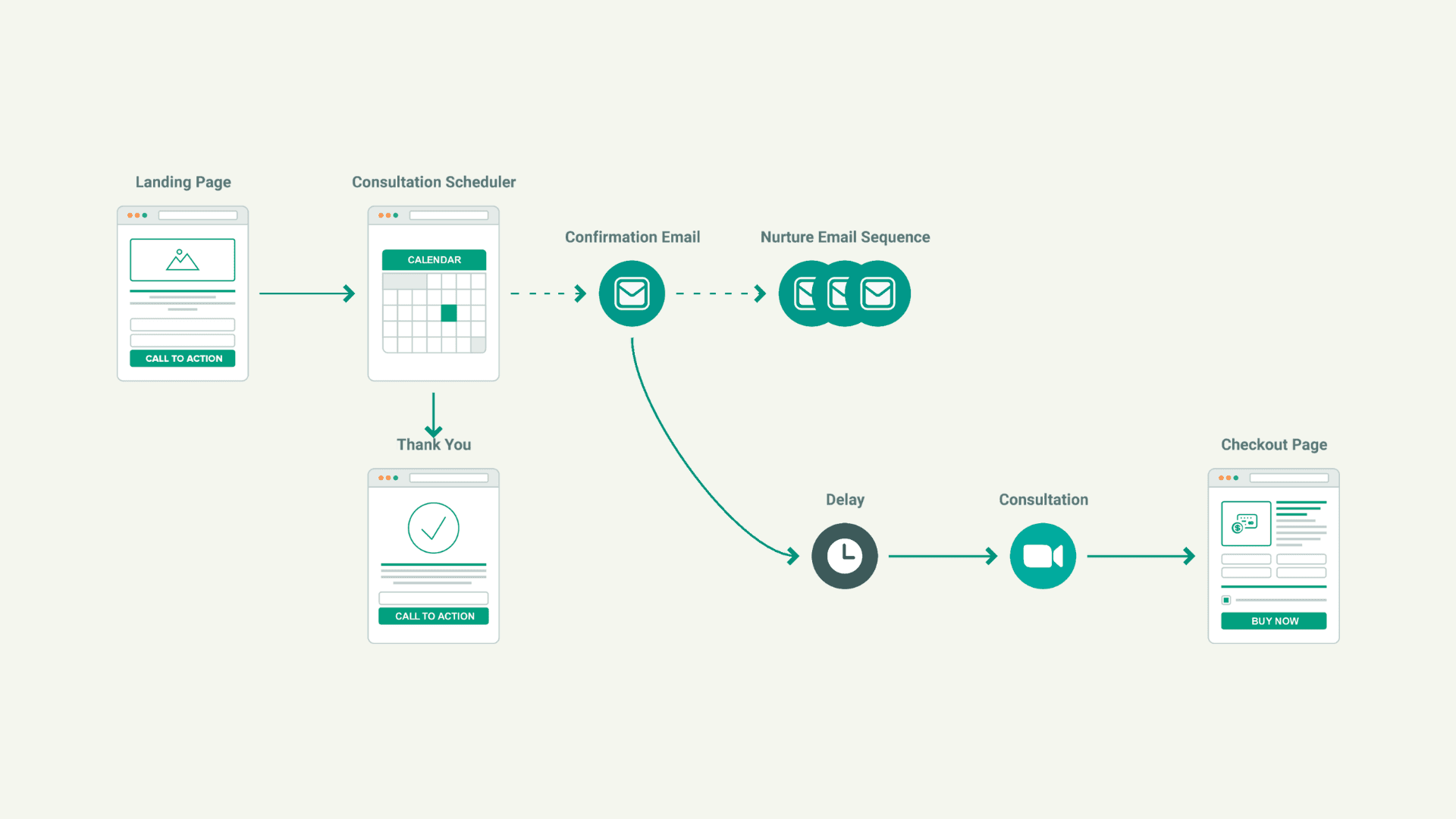
How this funnel is structured
- The funnel starts with a booking page where people schedule a free call, followed by a thank you page.
- After booking, they receive a confirmation email and nurture emails leading up to the consultation.
- During the consultation, you provide personalized advice and pitch your course if it fits their situation.
- After the consultation, they would go to the checkout page if they decide to enroll.
When to use a consultation funnel
Consultation funnels are perfect for high-ticket items or very personal topics. They work well when you need to build a strong personal connection and establish trust quickly.
For example, you might offer a free consultation if your course is about wealth management. The stakes are high, so trust is key.
Downsides of consultations
Consultation funnels require a significant time investment and might not be feasible for low-ticket products. They can also create a bottleneck if your schedule fills up quickly.
Book funnels
A book funnel uses a free or low-cost book to capture leads and build authority. Then the course is pitched as the next step.
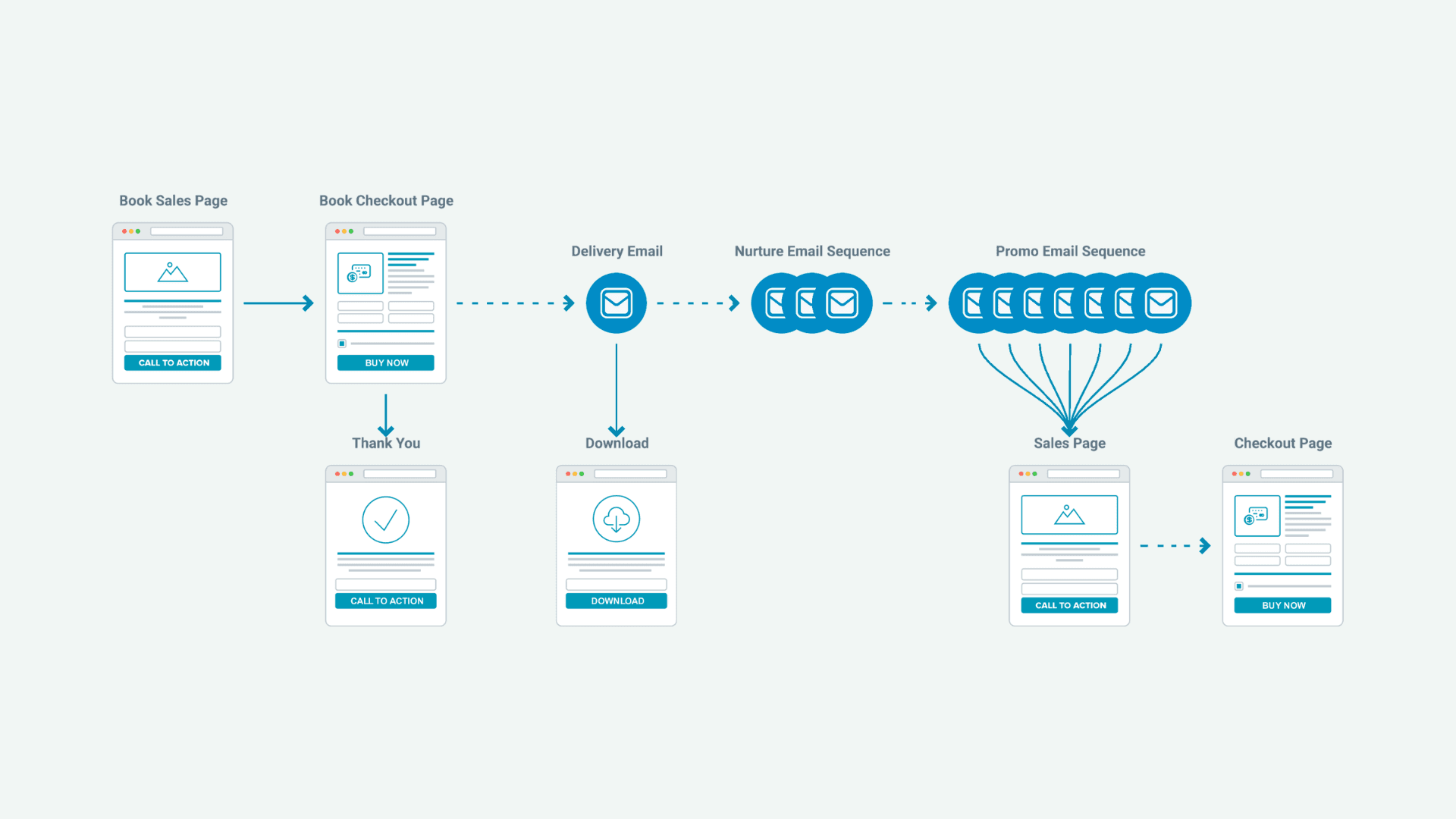
How this funnel is structured
- The funnel starts with a landing page offering the book for free (or at a low cost), followed by a thank you page.
- After they sign up, they receive a welcome email with download instructions or shipping details, and are placed into a nurture email sequence.
- The nurture sequence builds on the value offered in the book and sets the stage for the course.
- Then they’re added to a promo sequence that directs them to the course sales page, followed by the checkout page.
When to use a book funnel
Book funnels are great for establishing authority and providing in-depth value. They work well if you have existing book content that can serve as a lead magnet at the top of your online course sales funnel.
Downsides of books
Book funnels can be time-consuming to create if you don’t already have a book. They also might not work well if your audience prefers quicker, more digestible content.
They can also cannibalize your course sales if it’s unclear how the course builds on the book, so make sure your course involves extra value.
Challenge funnels
A challenge funnel engages your audience with a multi-day event, where participants complete daily tasks related to your course topic.
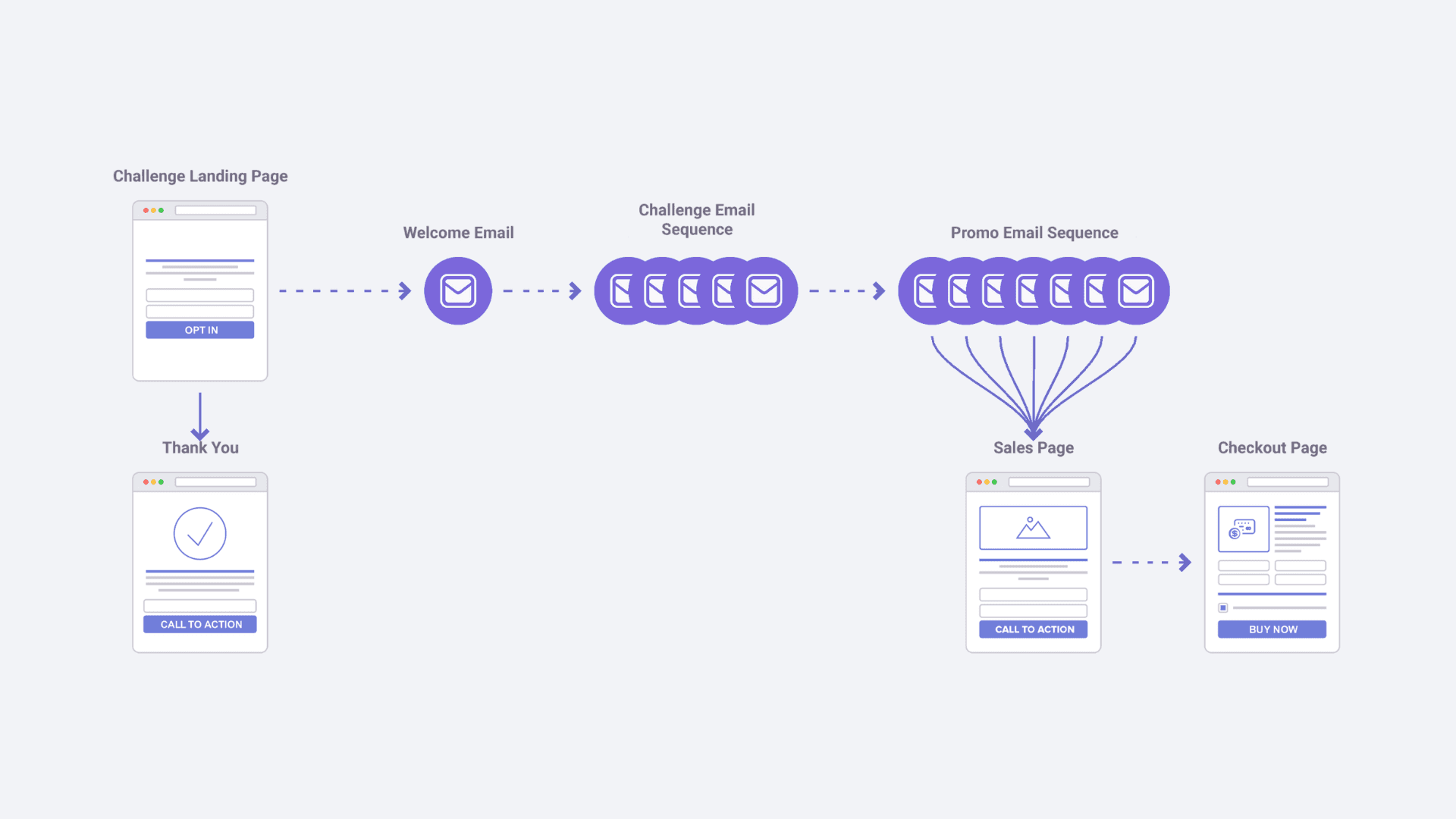
How this funnel is structured
- The funnel starts with a registration page for the challenge, followed by a thank you page.
- After registering, participants receive a welcome email and are placed into a daily email sequence that provides instructions and motivation for each day of the challenge.
- Throughout the challenge, you engage with participants through emails, social media, or a community group to keep them motivated.
- After the challenge, a promo email sequence leads them to the course sales page, followed by the checkout page if they decide to enroll.
When to use a challenge funnel
Challenge funnels are perfect for building momentum and getting participants excited about your course. They work well when your audience needs a kickstart to get moving toward their goals.
They can even function like a mini funnel within your online course sales funnel, helping people progress with their buying decision with strategic challenges.
Downsides of challenges
Challenge funnels can be time-consuming to set up and run. They need ongoing engagement to keep participants motivated, so they can be overwhelming if they’re not automated or managed properly.
Building your sales funnel
Building an online course sales funnel involves multiple tools and platforms to create a smooth journey for prospects. Here are the essentials.
Page builders
You’ll need a page builder to make your landing pages and thank you pages. Most course platforms will have a page-builder built in, but you might prefer the UX of other platforms.
What to look for in a page-builder
- Available integrations - You’ll need to send leads from your page to your email list, with information about the action they completed. So make sure your page-builder integrates with your chosen email platform.
- Pre-made templates - Unless you want to hire a conversion designer, look for a platform that offers high-converting templates.
- User-friendly - You need a platform that’s flexible but not complicated. Find one you’re comfortable using because you’ll be tweaking and troubleshooting a lot.
Pro tip
I like ConvertKit for landing pages. It connects directly with your email list if you use their platform, and it integrates well with most course platforms.
You might also want to try ClickFunnels, Leadpages, Framer, Unbounce, Instapage, Canva or Swipe Pages.
Webinar platforms
Webinar platforms are where you host your live or automated webinars. They usually have engagement features beyond what simple video platforms like Zoom can offer.
What to look for in a webinar platform
- Live, just-in-time, or evergreen options - Depending on your strategy, choose a platform that offers the type of webinar you need. They don’t all offer the same.
- Interaction features - Look for features like polls, Q&A, and chat to keep your audience engaged.
- Email integration - Make sure the webinar platform can send information to your email platform so you can follow up in the right ways (reminders, replays, etc).
Pro tip
I like WebinarKit for webinars. It’s a good price compared to other platforms; simple but effective; and it integrates well with most email platforms.
You might also want to try EasyWebinar, WebinarJam, GoToWebinar, LiveWebinar, ClickMeeting or Demio.
Email platforms
Email marketing platforms let you send automated email sequences to nurture leads and promote your course over time. They’re the backbone of any online course sales funnel.
What to look for in an email platform
- Automation features - Look for a platform that lets you set up automated sequences easily. Some platforms are more focused on broadcasts than automation.
- Integration with other tools - Make sure it integrates with your landing page, webinar, and course platforms.
- User-friendly - Choose a platform you find intuitive. Even if a tool can do everything you need, a confusing interface will become a problem as you scale.
Pro tip
I like ConvertKit for emails. It has flexible automation features that are intuitive to use, and it integrates with most tools. You can also build landing pages with it.
Other options include Mailchimp, ActiveCampaign, AWeber, GetResponse, MailerLite, Hubspot and Klaviyo.
Quiz builders
Quiz builders let you create interactive quizzes that give specific results based on how your audience answered.
What to look for in a quiz builder
- Branching logic - Make sure the platform lets you set up conditional logic that sends people down different paths based on their answers.
- Email integration - It needs to send the quiz results to your email platform to trigger personalized follow-up sequences.
- Gated results - Some quiz platforms don’t let you request an email address in exchange for the results, which is essential for a quiz funnel.
Pro tip
I like Interact for quizzes. It’s easy to use, offers plenty of conditional logic, and integrates well with most email platforms.
You might also want to try Typeform, Score, LeadQuizzes, QuizMaker, SurveyMonkey, Jotform or Outgrow.
Automation tools
Automation tools connect different platforms when there isn’t a direct integration. For example, if your email platform doesn’t integrate with your course platform, you can use an automation tool to bridge the gap.
What to look for in an automation tool
- Required integrations - Make sure the tool connects all the platforms you need to use.
- No-code setup - Choose a tool that’s easy to set up without any code. Some automation tools are targeted more towards developers than creators.
- Sensible pricing - Some automation platforms charge based on how many times an action is triggered, which can add up fast. Check the price makes sense for your estimated usage.
Pro tip
I like Zapier for automation. It connects a huge number of apps and it’s the industry leader. It’s easy to use without knowing how to code.
Other options are Integrately, Make and Pabbly Connect.
Common mistakes to avoid
It’s easy to make one small mistake that can prevent your online course sales funnel from working at all. These are the main ones.
Misaligned lead magnet
If you offer a lead magnet that doesn’t align with your main course, you’ll build a list of people who are unlikely to convert. For example, if your course teaches vert ramp skills:
- Bad: Beginner’s Guide to Skatepark Etiquette
This only appeals to beginners who are a long way from needing an advanced course. - Good: Cheatsheet of Vert Ramp Tricks
This only appeals to advanced skaters who are interested in learning how to skate the vert ramp.
Make sure you offer something only serious buyers would want.
Wrong lead magnet format
Using a format that doesn’t appeal to your audience can mean lower engagement and fewer conversions. For example, if your audience consists of busy parents:
- Bad: Live webinar about parenting techniques
Busy parents might struggle to commit to a specific time for a live webinar. It’s also a big time commitment. - Good: Mini course with bite-sized videos
A more digestible format means busy parents can engage with the content at their own pace.
Use the format your audience prefers and make sure it’s accessible to people who are most likely to buy. Your online course sales funnel needs to be a smooth experience for your ideal students.
Cannibal lead magnets
Offering a lead magnet that makes people think they don’t need your main course can reduce conversions. For example, if your course is about nutrition:
- Bad: Free Detailed Meal Plan
This might make people feel they have everything they need without taking your full course. - Good: Guide to Common Nutritional Deficiencies
This provides value but also highlights the need for your full course by assessing their nutritional needs.
Make sure you offer value but leave a clear need for your course so that people see the benefit of enrolling.
Low-quality lead magnet
Offering a lead magnet that lacks value or is poorly made can hurt your credibility and reduce conversions. For example, if your lead magnet promises to help people name their business:
- Bad: Surface-level advice that’s common sense
This can make potential students question the quality of your main course and they won’t convert. - Good: Detailed framework with helpful exercises
This shows your expertise and builds trust in your ability to help with their bigger problems.
Try to create a lead magnet of high enough quality that you could justify charging for it, in theory.
Infrequent emails
Many course creators worry about sending too many emails – but the vast majority don’t send anywhere near enough. If someone has just joined your list, they should get daily emails to start.
- Bad: Sending new subscribers 1-2 emails per week
They’re most interested when they first subscribe, but they’ll lose interest without regular contact. - Good: Emailing new subscribers daily, then twice a week
Regular contact keeps them engaged when they’re most interested, then you can gradually reduce the frequency.
Remember that people can unsubscribe any time and most people won’t open all of your emails. So don’t be shy with your frequency.
Lack of nurture
Failing to build a relationship with your leads before pitching will turn people away. For example, if you have a course that helps owners with reactive dogs:
- Bad: Promoting your course as soon as they subscribe
This is like proposing to someone on the third date. You’ve skipped many of the trust- and relationship-building steps that would enable the conversion. - Good: Sending 3-5 nurture emails before pitching
You’ve established more of a relationship before jumping straight to the proposal, making success more likely.
Earn the conversion by providing value and building trust first, otherwise it’s unlikely your online course sales funnel will work.
Excessive product focus
Focusing too much on the product instead of the value it provides makes it harder for people to buy. It’s your job to link the product with their specific situation. For example:
- Bad: “Module 1 is about leash-walking.”
This puts the course at center stage rather than the reader. It requires them to think about how it will benefit them, but it should be spelled out. - Good: “After Module 1, your dog won’t be pulling anymore.”
Use “you” sentences and relate the product to their pain points and desires. Your reader should be the main topic.
At least half of your copy should be about the audience. Even when talking about the product, highlight the benefits and how it helps them.
Not asking for the sale
Even if you’ve done everything right – if you don’t consistently ask for the sale, it won’t happen. You need to get comfortable making multiple CTAs over the long term.
- Bad: Only adding a “buy now” CTA in 2-3 promo emails
Leads might enjoy your content but it’s not the right time to enroll. If they don’t hear your CTA again after your initial funnel, they’ll disengage. - Good: Asking for the sale at least monthly
After your initial funnel, keep nurturing and asking for the sale on a regular basis. Some people take longer to make a decision and you need to be top of mind when they’re ready.
Remember – if your course helps people, it’s your responsibility to get them to buy it with the right amount of copy. Modesty won’t help your audience!
Examples of successful online course sales funnels
The best way to understand how funnels work is to seem in action for yourself. Here are some examples from leading online marketers.
Download funnel example
Marie Forleo uses a Yearly Goals Map as her free download. It’s a PDF that helps people clarify their business goals.
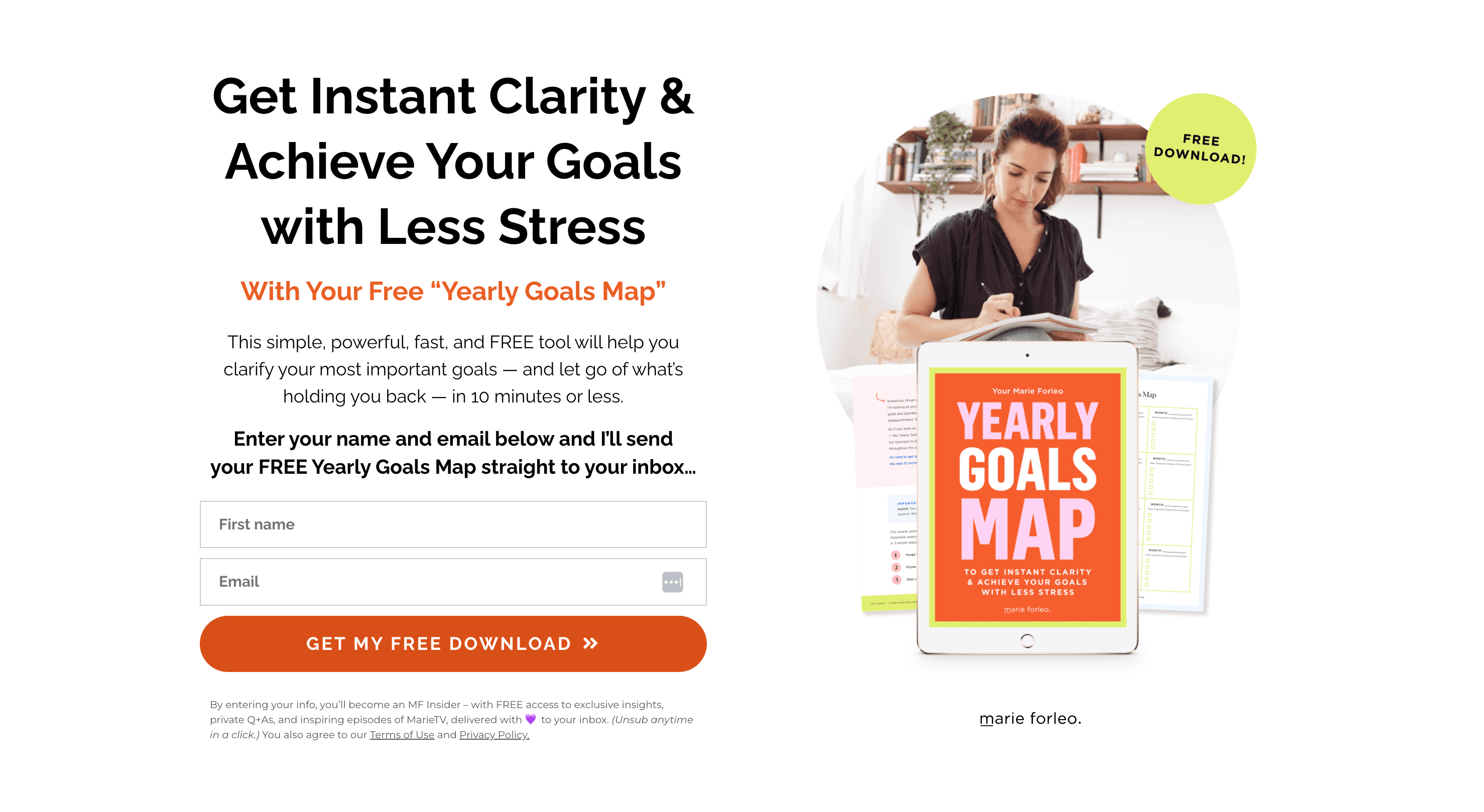
After requesting the download
- Training video - The thank you page shows a free training video that helps people get more value from the PDF (starting to nurture the relationship).
- Waitlist CTA - There’s immediately an option to join the waiting list for one of her main products, Time Genius.
- Content delivery - The PDF is sent directly by email, along with links to more free content about goals and time management.
- Nurture funnel - Subscribers start receiving a nurture/promo sequence that guides them towards various waiting lists for her live launches.
Mini course funnel example
Marie Forleo also offers a Free Writing Class as a 7-day mini course as a lead magnet. It’s delivered by email, but still structured like a mini course with content dripped out over time.
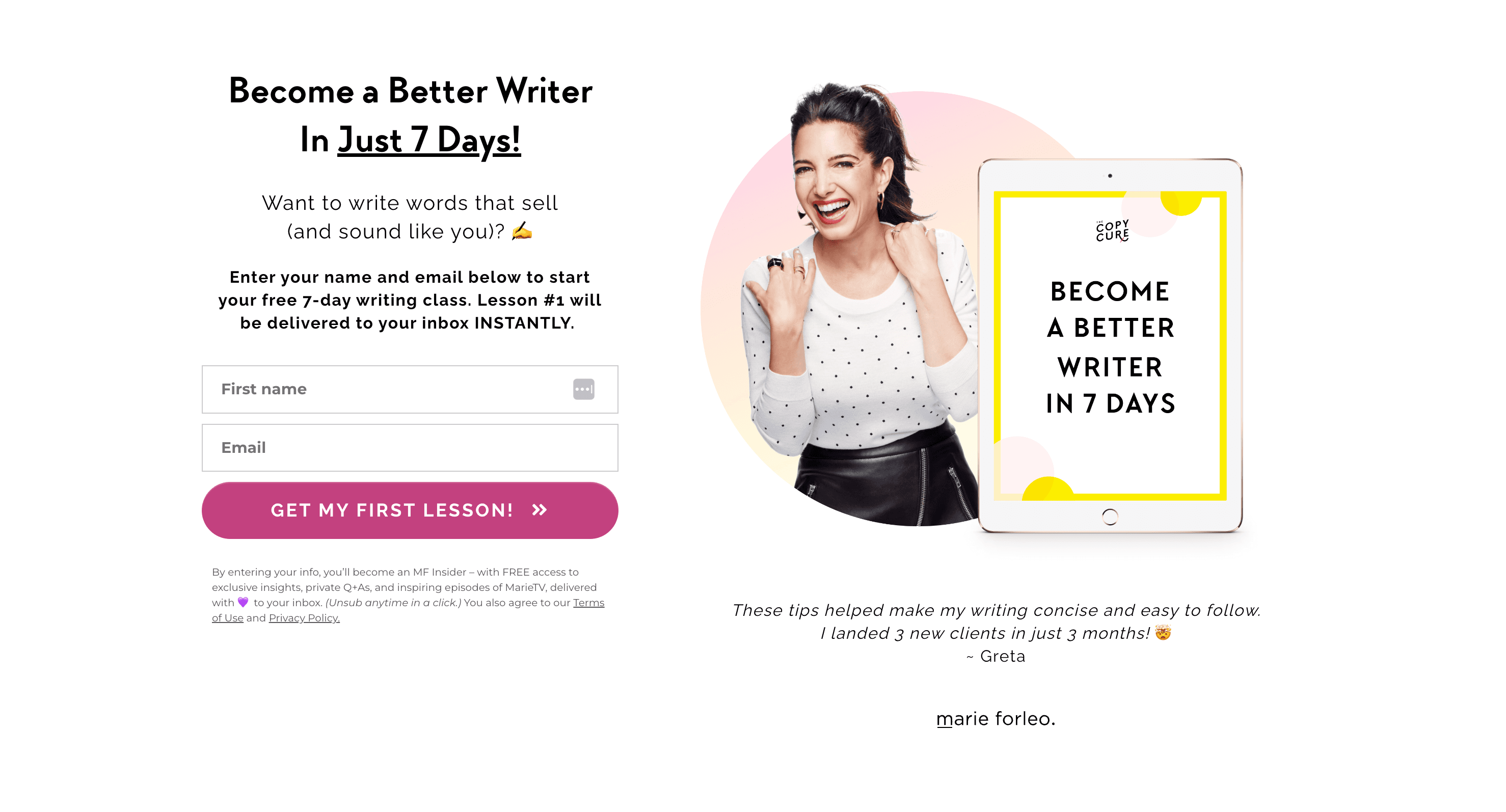
After signing up for the mini course
- Waitlist CTA - The thank you page encourages people to join the waiting list for her main product, Copy Cure.
- Email delivery - The mini course is delivered by email over 7 days, with each email containing a new lesson.
- Nurture content - As part of the course, subscribers get tips and training that function as nurture content.
- Audience survey - Subscribers are asked (optionally) to complete a survey about their pain points and goals, likely so that Marie can create more compelling promotional content.
Webinar funnel example
EasyWebinar offers a Conversion Webinar as a lead magnet. It’s a just-in-time webinar that sells potential users on the concept of using webinars (meta!).

After signing up for the webinar
- Thank you page - The thank you page confirms their registration and provides details on how to get access.
- Webinar session - A pre-recorded webinar starts within minutes. It educates viewers about the benefits of webinars and ends with a pitch for EasyWebinar itself.
- Follow-up emails - After the webinar, attendees receive a series of follow-up emails that vary depending on whether they completed the webinar or left early.
- Promo emails - Subscribers keep getting nurture content and emails that promote the main platform.
Waiting list funnel example
Marie Forleo uses a waiting list for her Time Genius course, offering early access and incentives to join the list.
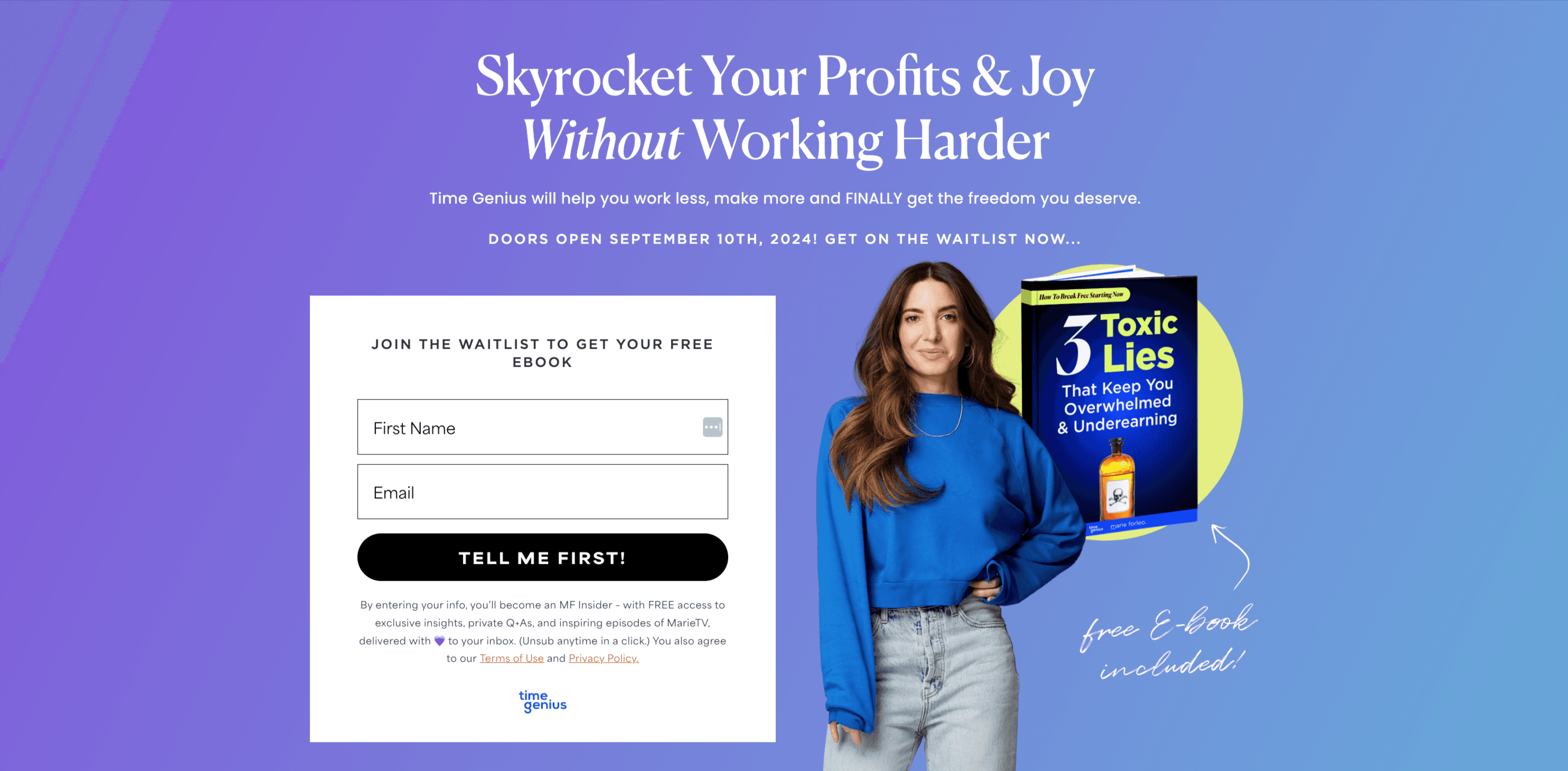
After opting into the waiting list
- Social media CTA - The thank you page suggests following Marie on Instagram and commenting with the #TimeGenius hashtag. This will mean she can nurture the relationship via social media and email.
- Incentive delivery - A free ebook is sent via email immediately, along with testimonials for the main product.
- Nurture emails - Leading up to the launch, subscribers get emails that build excitement and give more information about what to expect from the course.
- Launch emails - When Time Genius is ready to launch, subscribers get emails inviting them to enroll, often with a special offer or bonus for their early interest.
Book funnel example
Russell Brunson offers his book, DotCom Secrets, as a lead magnet, then offers multiple training products on the back end.

After opting into the book offer
- Thank you page - The thank you page confirms the order and provides upsell offers for related products.
- Shipping confirmation email - An email is sent immediately confirming the shipping details and providing a link to track the order.
- Nurture emails - Subscribers get a series of emails providing additional value and insights related to the book’s content.
- Promo emails - Follow-up emails encourage subscribers to join webinars, attend study events, or join an “inner circle” at increasing price points.
Quiz funnel example
Amy Porterfield uses an Entrepreneur Quiz as an entry point into her online course sales funnels, eventually promoting her paid programs.
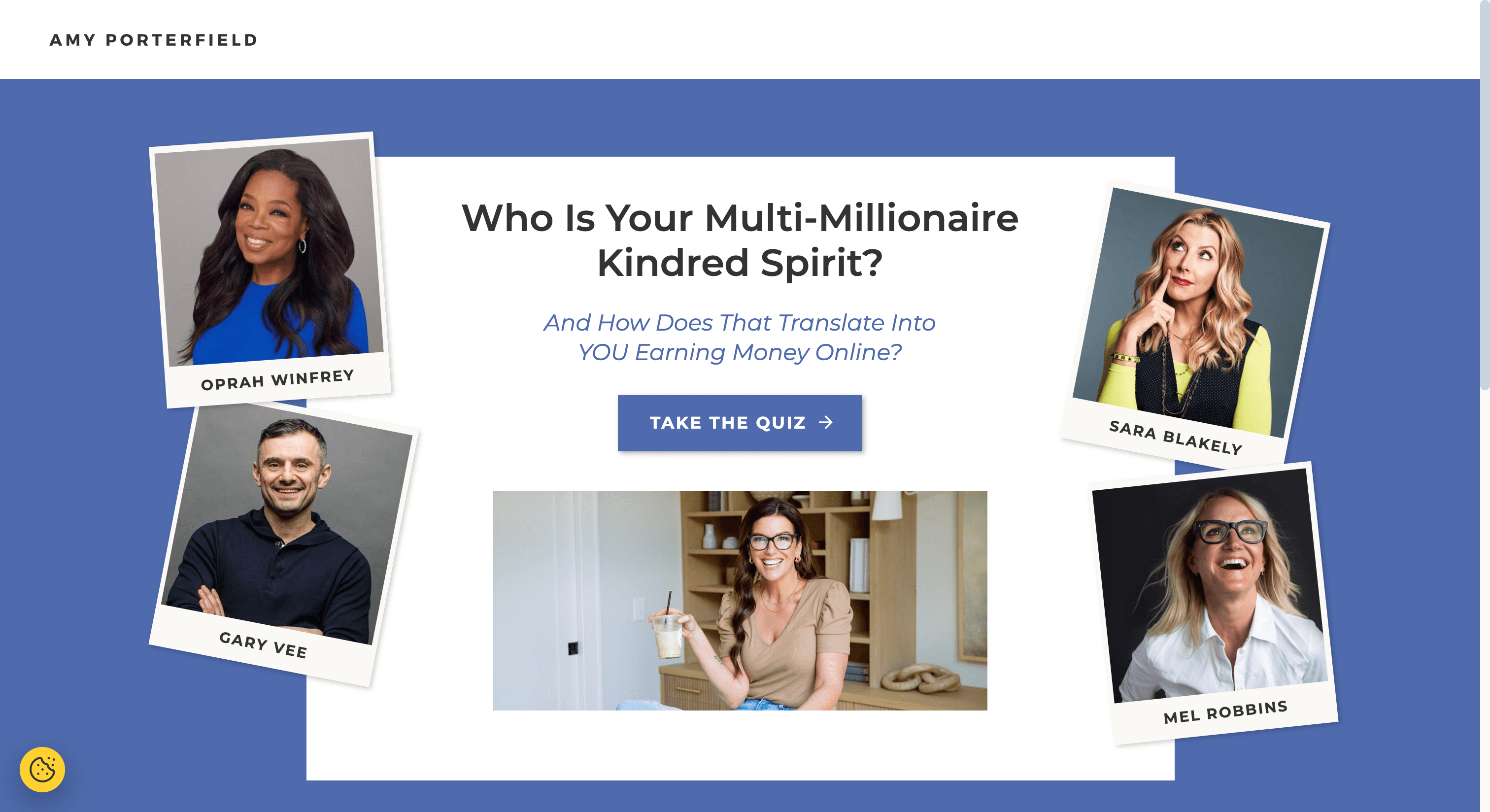
After taking the quiz
- Opt-in form - Before seeing their results, quiz takers need to provide their email address.
- Results page - The thank you page shows their quiz results and suggests a free episode of Amy’s podcast, related to their result.
- Welcome email - An email is sent immediately with their quiz results and a link to the podcast episode.
- Nurture emails - Subscribers receive a series of emails with content tailored to their quiz results, building “know, like and trust” with Amy over time.
- Promo emails - Follow-up emails encourage subscribers to check out Amy’s courses, with offers and promotions based on their interests and quiz results.
Challenge funnel example
ClickFunnels uses a 5-Day Lead Challenge as a gateway into their various sales funnels for their software.

After signing up for the challenge
- Thank you page - The thank you page confirms their registration and gives details about the challenge.
- Daily emails - Participants get daily emails with instructions and motivation for each day of the challenge.
- Nurture content - Throughout the challenge, participants are kept engaged with additional tips, videos, and community support.
- Promo emails - After the challenge, follow-up emails encourage participants to sign up for ClickFunnels and other training programs, with special offers and bonuses.
Consultation funnel
Alt Agency offers a Personalized Discovery Call as a lead magnet to attract potential clients and demonstrate their expertise.
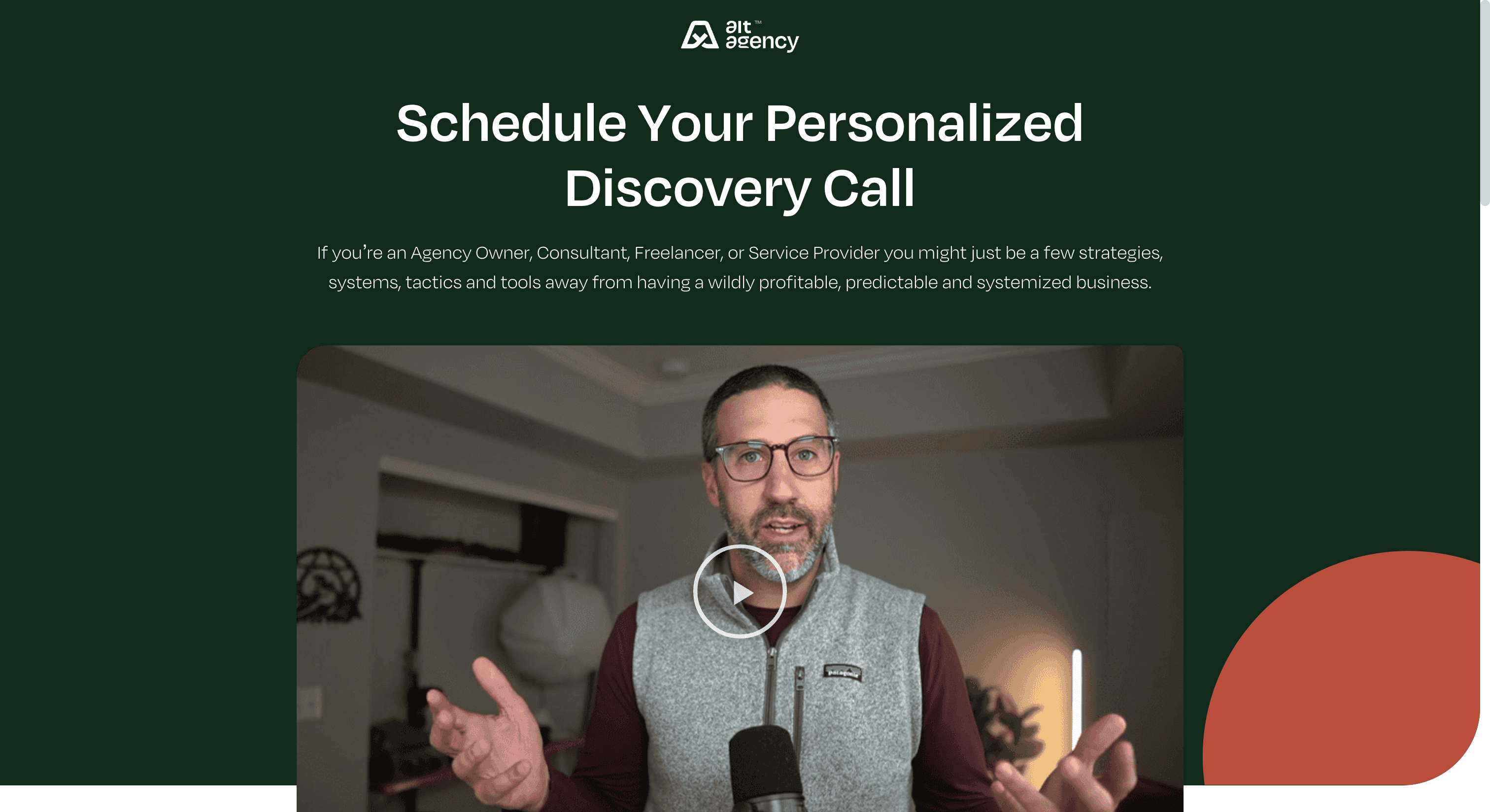
After booking the consultation
- Thank you page - The thank you page confirms the booking and gives details on what to expect during the call (also included on the landing page).
- Confirmation email - An email is sent immediately confirming the booking and sharing the meeting link.
- Consultation call - During the call, personalized advice is given and the main service is pitched if it’s a good fit.
Key takeaways
A well-structured online course sales funnel is essential for turning prospects into paying students. Here are the five most important lessons:
- Don't pitch on the first date - People rarely buy from complete strangers. Most people need at least 7 points of contact before they'll trust you enough to convert.
- Choose the right lead magnet - Make sure your lead magnet attracts the right audience. The wrong lead magnet can attract freebie-seekers and repel buyers.
- Nurture the relationship - Maintain regular contact (daily emails at the start) and provide value to build trust.
- Talk more about them than the course - Focus on how your course solves their problems and improves their lives. The reader is the topic, not your product.
- Ask for the sale - Make multiple calls to action over time. Ask for the sale in every promo email and don't stop when your main funnel ends!
Even with the right strategy, filling your online course sales funnel with the right words can be one of the hardest parts. With persistence and optimization, a solid funnel can generate steady results over time.
More blog posts
Beginner's guide to online course sales funnels
July 24, 2024 · 25 min read
How to use value-based marketing to sell your online course
December 12, 2024 · 8 min read
Long copy vs short copy for your course sales page
July 23, 2024 · 13 min read
Webinar invitation emails [steal my exact templates]
August 13, 2024 · 12 min read
Your first online course launch plan [evergreen launch]
July 24, 2024 · 18 min read
How to define your ideal customer avatar (a guide for course creators)
August 17, 2024 · 36 min read
